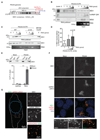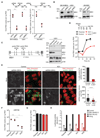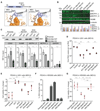Neurodevelopmental protein Musashi-1 interacts with the Zika genome and promotes viral replication
- PMID: 28572454
- PMCID: PMC5798584
- DOI: 10.1126/science.aam9243
Neurodevelopmental protein Musashi-1 interacts with the Zika genome and promotes viral replication
Abstract
A recent outbreak of Zika virus in Brazil has led to a simultaneous increase in reports of neonatal microcephaly. Zika targets cerebral neural precursors, a cell population essential for cortical development, but the cause of this neurotropism remains obscure. Here we report that the neural RNA-binding protein Musashi-1 (MSI1) interacts with the Zika genome and enables viral replication. Zika infection disrupts the binding of MSI1 to its endogenous targets, thereby deregulating expression of factors implicated in neural stem cell function. We further show that MSI1 is highly expressed in neural progenitors of the human embryonic brain and is mutated in individuals with autosomal recessive primary microcephaly. Selective MSI1 expression in neural precursors could therefore explain the exceptional vulnerability of these cells to Zika infection.
Copyright © 2017, American Association for the Advancement of Science.
Figures




Comment in
-
Why are neurons susceptible to Zika virus?Science. 2017 Jul 7;357(6346):33-34. doi: 10.1126/science.aan8626. Science. 2017. PMID: 28684491 No abstract available.
Similar articles
-
Dual Blades: The Role of Musashi 1 in Zika Replication and Microcephaly.Cell Host Microbe. 2017 Jul 12;22(1):9-11. doi: 10.1016/j.chom.2017.06.015. Cell Host Microbe. 2017. PMID: 28704657 Free PMC article.
-
Zika Virus-Induced Microcephaly and Its Possible Molecular Mechanism.Intervirology. 2016;59(3):152-158. doi: 10.1159/000452950. Epub 2017 Jan 13. Intervirology. 2016. PMID: 28081529 Review.
-
Zika Virus Disrupts Neural Progenitor Development and Leads to Microcephaly in Mice.Cell Stem Cell. 2016 Jul 7;19(1):120-6. doi: 10.1016/j.stem.2016.04.017. Epub 2016 May 11. Cell Stem Cell. 2016. PMID: 27179424
-
Differential Responses of Human Fetal Brain Neural Stem Cells to Zika Virus Infection.Stem Cell Reports. 2017 Mar 14;8(3):715-727. doi: 10.1016/j.stemcr.2017.01.008. Epub 2017 Feb 16. Stem Cell Reports. 2017. PMID: 28216147 Free PMC article.
-
Zika infection and the development of neurological defects.Cell Microbiol. 2017 Jun;19(6). doi: 10.1111/cmi.12744. Epub 2017 May 3. Cell Microbiol. 2017. PMID: 28370966 Review.
Cited by
-
Research advancements in the neurological presentation of flaviviruses.Rev Med Virol. 2019 Jan;29(1):e2021. doi: 10.1002/rmv.2021. Epub 2018 Dec 12. Rev Med Virol. 2019. PMID: 30548722 Free PMC article. Review.
-
Genome-wide CRISPR screen for Zika virus resistance in human neural cells.Proc Natl Acad Sci U S A. 2019 May 7;116(19):9527-9532. doi: 10.1073/pnas.1900867116. Epub 2019 Apr 24. Proc Natl Acad Sci U S A. 2019. PMID: 31019072 Free PMC article.
-
Cell-type-specific control of secondary cell wall formation by Musashi-type translational regulators in Arabidopsis.Elife. 2023 Sep 29;12:RP88207. doi: 10.7554/eLife.88207. Elife. 2023. PMID: 37773033 Free PMC article.
-
Musashi binding elements in Zika and related Flavivirus 3'UTRs: A comparative study in silico.Sci Rep. 2019 May 6;9(1):6911. doi: 10.1038/s41598-019-43390-5. Sci Rep. 2019. PMID: 31061405 Free PMC article.
-
Infectious disease: Musashi-1 protein could mediate the effects of Zika virus on brain development.Nat Rev Neurol. 2017 Aug;13(8):450. doi: 10.1038/nrneurol.2017.93. Epub 2017 Jun 23. Nat Rev Neurol. 2017. PMID: 28643807 No abstract available.
References
-
- Mlakar J, et al. Zika Virus Associated with Microcephaly. The New England journal of medicine. 2016;374:951–958. - PubMed
-
- Oliveira Melo AS, et al. Zika virus intrauterine infection causes fetal brain abnormality and microcephaly: tip of the iceberg? Ultrasound in obstetrics & gynecology : the official journal of the International Society of Ultrasound in Obstetrics and Gynecology. 2016;47:6–7. - PubMed
-
- Slavov SN, Otaguiri KK, Kashima S, Covas DT. Overview of Zika virus (ZIKV) infection in regards to the Brazilian epidemic. Brazilian journal of medical and biological research = Revista brasileira de pesquisas medicas e biologicas / Sociedade Brasileira de Biofisica … [et al.] 2016;49:e5420. - PMC - PubMed
Publication types
MeSH terms
Substances
Grants and funding
LinkOut - more resources
Full Text Sources
Other Literature Sources
Medical

